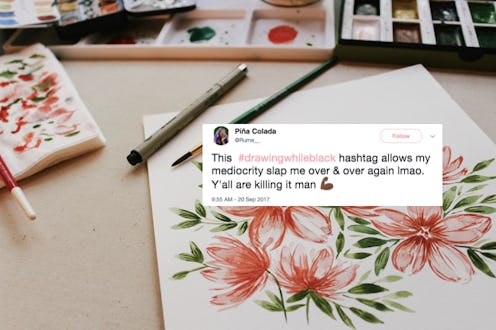Life
“Drawing While Black” Hashtag Highlights Black Artists & Illustrators, & It’s So Necessary
If you've been paying any attention to Twitter lately, you may have been drawn into the amazing trending topic, #DrawingWhileBlack. Organized by a teenage illustrator named Annabelle, who happens to be a first-generation Ghanaian immigrant to the U.S., the hashtag rapidly attracted thousands of submissions from Black illustrators, cartoonists, and artists from across the digital sphere. Some of them were in prominent positions (Disney animators and Marvel concept artists joined in), and others were promoting work that rarely sees professional appraisal. But the whole point of #DrawingWhileBlack — one that was rapidly hijacked by trolls who declared that "drawing while white" was important too — was to highlight the consistent issue of racism in creative fields. Across the many areas of professional visual art, from animation to cartoons to paintings in galleries, Black artists, and Black women in particular, remain at a disadvantage.
The sheer numbers of the #DrawingWhileBlack respondents and the high calibre of their art dispelled the myth that employers looking for Black artists "couldn't find one good enough," as some tweeters noted. The social media celebration of skill and community has captivated the internet, but it also points to a widespread issue in artistic industries in general, and how difficult it still is for talented Black artists to make it professionally.
Black Female Illustrators & Animators Are Still A Small Minority
As many people noted on the #DrawingWhileBlack thread, for every example of Black illustrative excellence, there are many who can't get a break, and the problem definitely doesn't have to do with a lack of talent. It's a particular problem for Black women and non-binary people. Marvel only employed its first female Black comic book writers in 2016, for example, and a survey by Truthout and comic strip Ladydrawers in 2012 found that only 39 percent of comic book creators were female, compared with 54 percent male, even though they submitted work to publishers at the same rates. And that's despite floods of brilliant work: the directory Women Who Draw, which was explicitly designed to "increase the visibility of female illustrators, female illustrators of color, LBTQ+, and other minority groups," debuted in February 2017 and promptly crashed thanks to thousands of submissions.
The situation isn't better in other drawing-based fields. Studies have revealed that it's rare for children's books illustrated by women to win the much-coveted Caldecott Medal, for instance, and the Hollywood Reporter caught a lot of criticism in 2016 for inviting only white men to their animator's roundtable — and then asking them to discuss diversity. The first Black female animator to gain widespread acclaim, Brenda Banks, only started to work in the 1970s, and few women have risen to prominence after her. While illustration as an industry have been attempting to prioritize diversity in recent years, the pressure hasn't yet led to world-changing results.
The Problem Is Mirrored In The Art World As A Whole
Illustration is only one sector of a vast art industry that involves many mediums, and the challenges for Black creators, and female ones in particular, are mirrored in others too. Artnet, looking at the racial bias in the worldwide art auction market in 2016, noted that while several Black artists appear in most-expensive lists, only 11 appear in the top 100 artists by volume. In the list of most expensive artworks sold by auction since 2010, there's only one Black artist — David Hammons, at number 100. Only ten percent of the American artists whose works regularly sell at over $1 million at auction are Black.
Museum galleries are another venue for examining how racism and sexism in the art world manifests. In 2004, the Museum of Modern Art in New York opened a new building in which only 4 percent of the works were by women, and even fewer were by people of color. By 2015, the percentage of works at MOMA that had been done by women rose slightly — to 7 percent. The Whitney, Art News also noted, has only devoted 29 percent of its solo shows to female artists. And the museum's Biennial has encountered persistent criticism for its low percentages of female and non-white artists; in 2014, for example, only nine of the entire 109 artists shown were Black.
Beyond artists whose work makes it into museums and galleries, everyday working artists also face some striking statistics: according to research in 2014, 77.6 percent of all the artists who can afford to support themselves with their art are white. 92 percent of all museum-goers and 80 percent of museum studies graduates are white. It isn't easy to be a Black artist when these institutions don't prioritize inclusivity.
At one end of this thread is a hashtag celebrating Black talent, particularly female talent, through gorgeous images all over Twitter. At the other is systematic bias throughout the many different levels of the artistic industry, from audiences to buyers. It continues to be a hard world, and #DrawingWhileBlack is a reminder of the talent that remains, in many ways, unfairly untapped.
